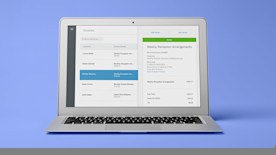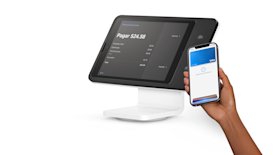![]() Investigación
InvestigaciónInforme El futuro de los restaurantes: edición 2023
![]() Investigación
InvestigaciónInforme El futuro de las tiendas: edición 2023
![]() Artículos
ArtículosSeis formas de pago sin contacto y a distancia
![Person creating online store on laptop]() Investigación
InvestigaciónCómo abrir una tienda en línea
¿Estás pensando en abrir una tienda en línea? Aquí encontrarás todo lo que tienes que saber y los pasos que debes seguir para comenzar.
![]() Guías
GuíasCómo abrir un salón de belleza
¿Estás considerando abrir un salón de belleza? En esta guía te contamos todo lo que necesitas saber, incluida una lista de verificación para abrir un salón de belleza y consejos para administrar exitosamente el negocio.
![]() Artículos
ArtículosCómo aceptar pagos con tarjeta por teléfono
¿Necesitas aceptar pagos con tarjeta por teléfono? Terminal Virtual de Square puede ayudarte.
![]() Guías
Guías¿Qué es el procesamiento de tarjetas de crédito y cómo funciona?
En esta guía, te explicaremos todo lo que necesitas saber sobre el procesamiento de las tarjetas de crédito y cómo seleccionar la mejor opción para tu negocio.
![Best Small Business Ideas 2022]() Artículos
ArtículosLas mejores ideas de pequeños negocios para 2022
¿Eres una persona emprendedora que busca ideas de pequeños negocios para aprovechar el nuevo año? Hemos creado una lista de ideas de negocios para 2022.
![credit card authorization form templates [PDF]]() Artículos
ArtículosPlantillas de formulario de autorización de la tarjeta de crédito [PDF y Word]
Aceptar pagos por tarjeta de crédito sin la tarjeta en mano puede ser arriesgado. Para protegerte de ese riesgo, prueba este formulario de autorización para tarjetas de crédito.
![]() Artículos
ArtículosProgramas de fidelización: por qué son importantes y cómo crearlos
El 42% de los propietarios y directivos de restaurantes tienen previsto ofrecer programas de fidelización nuevos o ampliados en 2021. Es por eso que deberías considerar la posibilidad de establecer uno para tu restaurante. Aquí te explicamos cómo comenzar.
![]() Artículos
Artículos¿Cuánto cuesta abrir un restaurante?
Los costos iniciales de un restaurante son lo más importante para los nuevos propietarios. ¿Cuánto cuesta realmente abrir un restaurante?
![]() Artículos
ArtículosCómo configurar pagos recurrentes
Cobra más rápido con pagos recurrentes. Siempre son gratuitos con Facturas Square. Obtén información sobre cómo configurar pagos automatizados para cobrar siempre a tiempo.
![How to Start a Free Online Store from Your Square Account]() Investigación
InvestigaciónCómo abrir una tienda en línea gratis desde tu cuenta de Square
Si ya usas Square y quieres hacer que tu negocio crezca, llegar a más clientes e incrementar las ventas es fácil con un sitio web de comercio electrónico gratis con Ventas en Línea Square.
![]() Artículos
ArtículosCómo elegir el mejor dispositivo de tarjetas para tu negocio
Existen muchos factores a tener en cuenta a la hora de elegir el mejor dispositivo de tarjetas para tu negocio. Esta guía te ayudará a entender qué buscar para que puedas tomar la decisión correcta.
![]() Artículos
ArtículosConvierte cualquier computadora portátil en un Punto de venta virtual (PDVV) gratis
Aceptar pagos en cualquier momento y en cualquier lugar es posible con un Punto de venta virtual.
![]() Artículos
ArtículosCinco formas en las que un sitio web de comercio electrónico puede mejorar tu negocio
Más de la mitad de los compradores comienzan su proceso de compra con una investigación en línea, informa eMarketer. Si no pueden encontrar tu negocio en línea, pierdes ventas.
![]() Guías
Guías¿Qué es una pasarela de pago? (Y por qué no la necesitas)
Las pasarelas de pago permiten a los comercios aceptar pagos con tarjetas de crédito al conectar a los procesadores de pagos con los proveedores de cuentas de comercio.
![]() Artículos
ArtículosOnce ventajas de la facturación móvil que podrían sorprenderte
Cobra más rápido con la facturación móvil. Conoce las once ventajas principales de las facturas móviles, además de aprender lo fácil que es enviar facturas gratis con la aplicación Facturas Square.
![]() Artículos
Artículos¿Cómo funcionan los lectores de tarjetas de crédito?
How credit card processing machines work.
![]() Artículos
ArtículosProcesamiento de tarjetas de crédito sin conexión: acepta tarjetas de crédito sin conexión
Square facilita el procesamiento de tarjetas de crédito sin conexión gracias a sus bajas tarifas de procesamiento Acepta tarjetas de crédito en cualquier momento, sin necesidad de Wi-Fi.
![How to Accept Apple Pay at Your Business]() Videos y seminarios web
Videos y seminarios webCómo aceptar Apple Pay en tu pequeño negocio
Tener Apple Pay en tu negocio es fácil, pero primero tienes que aprender a aceptarlo como método de pago. Esta es una guía completa para configurar Apple Pay en tu negocio.
![]() Artículos
ArtículosPor qué tu salón necesita un programa de Fidelidad
Descubre qué es un programa de fidelidad y las cinco razones por las que tu salón necesita uno.
![]() Artículos
ArtículosRecibe el año nuevo con estas nueve ideas de marketing festivo
No hay mejor manera de cerrar este año y dar un impulso a tus ventas para el próximo, que con una promoción festiva para el nuevo año.
![]() Artículos
ArtículosSiete consejos fáciles de implementar para evitar robos en las tiendas
¿Quieres saber cómo proteger tu mercancía? Aquí encontrarás algunos consejos que pueden marcar la diferencia.
![]() Artículos
ArtículosCómo mejorar el inventario detrás del bar
Controlar el inventario de un bar es un concepto importante de dominar cuando abres un bar por primera vez. Obtén información acerca de los beneficios y las formas de mejorar tu control de inventario.
![]() Guías
Guías¿Qué son los pagos móviles? ¿Cómo se usan?
Los pagos móviles son pagos sometidos a regulación financiera y realizados desde un teléfono móvil con capacidades de NFC. Estos son los motivos por los que tu negocio debería aceptarlos
![]() Artículos
ArtículosEquipamiento esencial para tu cafetería
Pensar en todo el equipamiento necesario para tu cafetería puede ser abrumador y dificultar el proceso de selección. Aquí encontrarás una lista resumida del equipamiento que necesitas para tu tienda.
![gadzooks]() Artículos
ArtículosCómo este QSR en crecimiento utiliza la tecnología para controlar la locura de los restaurantes
Conoce cómo los hermanos Pool usan la tecnología para que sigan llegando pedidos a GADZOOKS.
![]() Artículos
ArtículosCómo completar y presentar el formulario SS-4
Si estás comenzando un negocio nuevo, tendrás que completar y presentar el formulario SS-4. Te mostraremos cómo hacerlo.
![restaurant trends]() Artículos
ArtículosLas principales tendencias de los restaurantes en 2022
Encuestamos a 1000 clientes y 500 dueños sobre tendencias en 2022. Conoce sus mayores apuestas.
![online shopping]() Artículos
ArtículosLas principales tendencias del comercio electrónico para 2022
El comercio electrónico está cambiando cada aspecto de la forma en que las personas venden, compran, cenan y canjean servicios. Entonces, ¿qué tienes que saber como propietario de un negocio?
![]() Artículos
ArtículosLas principales tendencias para las tiendas en 2022
¿Cuáles son las principales tendencias de las tiendas en 2023? Obtén información sobre el creciente sector de tiendas, desde innovaciones en el comercio electrónico hasta tiendas físicas y modelos de negocios alternativos.
![]() Artículos
ArtículosCuándo se deben pagar los impuestos trimestrales: Fechas a tener en cuenta
Estas son algunas de las fechas más importantes relacionadas con los impuestos que debes recordar como propietario de un pequeño negocio.
![How to retain employees]() Artículos
ArtículosConsejos y herramientas para conservar a tus mejores empleados
Nearly 41 percent of U.S. workers will look for a new job within the next year, according to a recent study. Here are ways to retain your top employees.
![]() Guías
GuíasCómo abrir una tienda
Aférrate a tu espíritu emprendedor y cumple tu sueño de abrir una tienda. Aquí encontrarás todo lo que necesitas saber sobre cómo abrir una tienda.
![Woman using a mobile phone at home.]() Artículos
ArtículosComercio conversacional: qué es y por qué está en auge
El comercio conversacional permite que las marcas se conecten con los clientes y les vendan mediante chat y tecnología de voz. Esto es lo que tienes que saber sobre esta tendencia de compra.
![]() Artículos
ArtículosCómo elegir la plataforma de tienda en línea adecuada para tu negocio
¿Cuál es una de las primeras decisiones que tomas una vez que estás listo para dar el paso a la modalidad en línea? Elegir una plataforma web.
![Shop owner selling plants via livestream video.]() Artículos
ArtículosLas compras en vivo están pasando por un gran momento: cómo puedes comenzar
Las tiendas están recurriendo a la transmisión en vivo en las redes sociales y otras plataformas para recrear la sensación de conexión que sienten los clientes cuando compran en una tienda física.
![How to do payroll yourself]() Artículos
ArtículosCómo configurar la nómina para tu pequeño negocio por cuenta propia
Procesar tu propia nómina es más fácil de lo que crees. Comienza a ahorrar en gastos de nómina hoy mismo al aprender tres formas sencillas de configurar la nómina por cuenta propia.
Centro de Recursos para Negocios
Town Square
Página 1 de 8
Mostrando 1–39 de 259 artículos








![credit card authorization form templates [PDF]](http://images.ctfassets.net/2d5q1td6cyxq/6N8Ku5xE4ahVzn6kgiwR2G/7f34bc5f7ad52e0878d5ed6cd46a31ab/170828_SquareX2_Payment_Moment_Undocked_VisaTap_JN_01.jpg?w=276&h=155&fit=thumb)





























